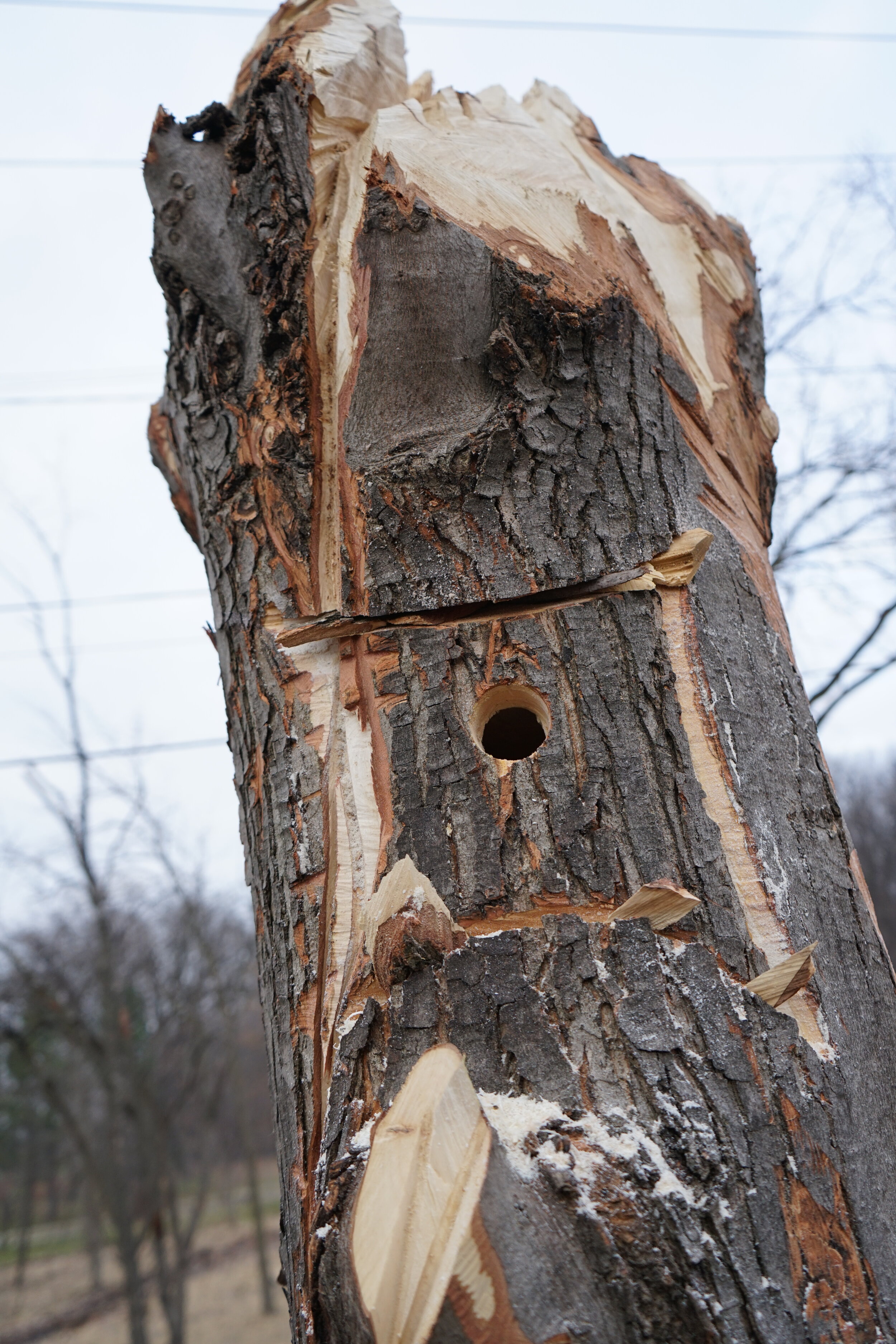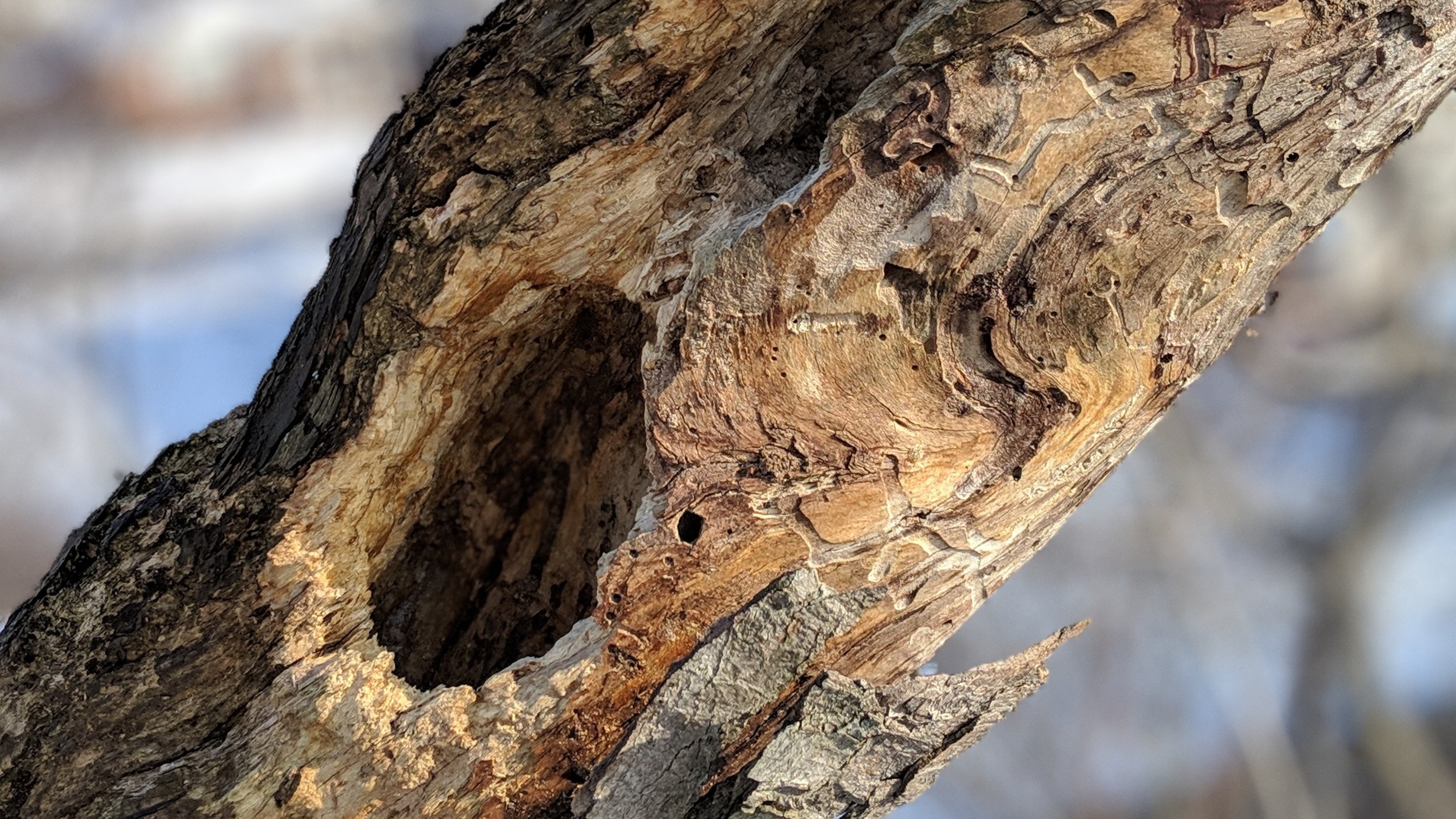What is a Snag?
A standing dead tree, or dead tree parts
An artificial snag Tree First made for customers in Royal Oak, MI
A dead standing tree is called a snag. Snags can be naturally formed or man-made, in all shapes and sizes. Both living trees and dead trees are habitat to millions of different animal species across the planet. As the modern understanding of the important roles trees play in our ecosystem grows, the way we manage trees grows too.
In states that log their forests, they are required by law to leave or create a number of snags per acre that they harvest. This is to mitigate the extensive habitat loss caused by logging. Dead trees are highly valuable and useful to wildlife as living trees.
The same extensive habitat loss is caused by the creation of our urban forest. Entire acres leveled to build our houses on, without the retention of old and dead trees. It becomes an artificial landscape rebuilt on top of a once natural one.
As we replant our environment we often don’t allow trees to live their entire lifespan and fulfill their roles in the ecosystem. Once trees reach a certain aesthetic or are undesired for whatever reason, they’re prematurely removed. Sometimes that’s the right course of action, and sometimes it’s not. A single tree in a natural forest serves thousands of other organisms, even once it has been dead for decades.
However, a tree does not have to be entirely removed. We are bringing the snag into the urban forest.
We’re not the only ones living here
Improving the quality of our urban forest requires some rethinking of what nature is supposed to look like. That requires both environmental mindfulness, and an awareness of the long term impacts we have on other animals and plants.
The more time I spend with trees the more my view of beauty expands. Not all trees have to look perfect and neat. To me the most beautiful, revered trees are old and haggard. Pristine because they are literally pillars of life in their environments. All parts of the trees, either living or dead, support a litany of other organisms by providing food, shelter, and protection from predators and temperature. Technically, you too are protected by dead tree parts.
A small cavity made by a woodpecker in dead wood of a silver maple while it searched for insects and woodlouse to eat. Now that he’s left, something can live in here! This in-tree snag was retained, and is monitored for stability. Madison Heights, MI
If you look at the bark of a tree, you see lichen. On the leaves, you can find insects feeding and fighting. In cavities you may find nesting birds, or maybe even raccoons. The dead parts support life too of course: fungi and other microbes decompose dead tissue, contributing to the nitrogen cycle. Amphibians live beneath rotting logs on the ground.
Throughout a tree’s life, from a sapling to a veteran, they’re being utilized by something else. The older they are, the more species they’ve helped and are currently helping. When the tree dies, it is usually still standing and serving that same purpose.. The big deal is that they’re not only your trees, they’re everyone’s trees.
You can have your own snag
If a tree is determined to be hazardous, it can be turned into a snag. Rather than removing the tree outright, the tree can be reduced in size to mitigate the immediate hazards. You can also add mini snags into a living tree.
A typical large snag has all of its major limbs removed, and is just left as a standing trunk. Sometimes it’s called a ‘monolith’. The monolith is made to look like it naturally broke, and habitat features are added to it, such as carving bat houses or drilling cavities for birds. Although the monolith is a very safe structure, like any other tree, it should be monitored regularly. As time goes on it decays more and more and the snag will eventually be reduced, until it is finally gone.
A very old, naturally occurring, gorgeous monolith snag of an american beech, discovered in Tenhave Woods in Royal Oak, MI
Snags make for unique additions to the landscape. Around the base of the snag, we recommend planting a wildflower garden to attract more insects and add to the overall aesthetic.
The benefits of retaining snags is fairly obvious at this point. The wildlife gets to keep its home. Now that all of the most important ecological benefits have been stated, it is worth mentioning the cost savings.
Removing trees can be extraordinarily expensive and extraordinarily dangerous. Part of the cost is dealing with and disposing of the large heavy wood once it is removed from the property. Frankly speaking as an arborist, sometimes dealing with the wood is the worst part of tree removals. Not having to remove all of the wood translates to a fairly large cost savings for anyone needing a tree removal.
Any major wood that does get removed from the tree should stay on the property to become habitat on the ground for smaller mammals and amphibians, called a nurse log.
Who can have a snag? If you’re into bird watching, you definitely need a snag. If you are interested in ecological responsibility, sustainability, and being cutting edge, you could use a snag.



